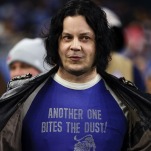It wasn’t all that long ago that viewers looking for fun, progressive, weighty genre shows could find it on The CW. The network was a beacon when it came to diverse casts mixing it up in the realms of science fiction, horror, and superheroes. From the campy but emotionally honest The Vampire Diaries to post-apocalyptic parable The 100, The CW did a good job of being inclusive and representative when it came to race, gender, and sexuality, all while holding on to the idea that genre shows should amuse—quite the statement in an age of self-serious prestige TV.
For those reeling from these developments, there’s a cable channel quietly preparing to fill the hole The CW has left behind. (If you squint, you’ll see it’s over there behind the pile of dead characters.) At a glance, the current Syfy lineup is exactly what you’d expect to see from a channel catering to sci-fi and genre fans. In addition to Wynonna Earp, there’s the time-travel intrigue of 12 Monkeys, the amnesia-induced identity crisis of Dark Matter, the quick-talking assassins-in-space of Killjoys. Each of these shows is worthwhile based on storytelling alone, but it’s the inclusive atmosphere that Syfy is creating that really merits attention.
Casting is one of the ways in which Syfy’s shows are leading the pack. After all, sci-fi and genre TV have long been some of the leading forces in creating stories for LGBT and POC characters. It’s not just about creating worlds where sexuality or skin color isn’t commented on, like in the genderless world of Ursula K. Le Guin’s The Left Hand Of Darkness or the normalized bisexuality of Other Space. It’s also about creating stories that challenge prescribed roles, both in terms of race and gender, as in the political themes of Sense8 or the complex relationship between and reactions to Jack Harkness and Ianto Jones on Torchwood.
Speculative fiction can often wade more confidently into issues of representation, and perhaps that long history of speculation is starting to become more commonplace, less an outlier and more the norm. Joseph Mallozzi, longtime writer for the Stargate franchise and current writer and showrunner for Dark Matter, sees the diversity of the show’s cast as a reflection of the world he lives in. “I was heavily influenced by anime, and I guess by the life I lead. As a result, the characters I created, the characters I envisioned, just happened to be diverse.”
Even if the characters “just happen” to be diverse, the show itself uses that casting to tell a meaningful story about subverting expectations based on one’s prescribed identity. Dark Matter is about six space travelers who wake up from a cryogenic sleep with no memory of who they are. Over the course of the first season, they grapple with who they know themselves to be in their hearts, while little pieces of evidence suggest otherwise. In essence, Dark Matter is about identity, and about overcoming prescribed roles. The characters are given numbers as names because they’re blank slates, and a diverse cast allows for a more dynamic and challenging story because it plays on our sense of what these people should be. That means that the character of Four, played by Filipino-Canadian actor Alex Mallari Jr., becomes more than just a brooding swordsman, and Two, played by Melissa O’Neil, feels right at home as the ship’s leader. There’s no discussion of why she takes on the role, or whether she’s suited for the job. It’s just who she is at her core, even if she knows nothing about her identity.
Mallozzi wrote a series of Dark Matter comics before pitching the show, figuring it was easier to come in to the show with his ideas already established in a visual, physical medium. From there, the casting call was open: “We opened up the roles to all ethnicities and a couple of the roles to all genders.” That willingness to change course and be inclusive led to the role of Dark Matter’s android, a male in the comics, being given to Zoie Palmer, who finds the emotion in an otherwise robotic character. Allowing for this kind of casting fosters a sense of not only inclusivity, but also creativity. Killjoys creator and writer Michelle Lovretta—who was also at the helm of the Canadian import Lost Girl, which centered on a bisexual succubus—has similar thoughts, but also thinks that representation needs to be kept in mind well before the writers’ room so that “it’s baked into your show and not just afterthought window dressing.”
That seems particularly relevant when discussing Killjoys, a show that includes a badass female lead played by Hannah John-Kamen, an English actress born to Nigerian and Norwegian parents. Lovretta posits that “some writers have a misconception of the role of diversity, which gets their hackles up. They think they’re being pressured to use story to serve diversity, when the opportunity is using diversity to serve story.” That means telling stories that weren’t told before. Lovretta describes Killjoys and its main character, Dutch, in Star Trek terms: It’s “Uhura running things.”
Mallozzi is quick to point out that he doesn’t have an agenda when considering casting and writing roles, but that statement itself almost speaks to the importance of representation. The idea is that if the TV shows, movies, and other forms of art that we consume better reflect the world we live in, then the inclusion of minorities or any other group of underrepresented people won’t feel as if it’s part of an agenda, but rather just the way things are. Wynonna Earp creator Emily Andras believes that genre TV in particular has the capacity to be at the forefront of the medium’s push toward more inclusive casts and progressive messages: “Genre is the realm of the outsider. It’s where outsiders come to play. That’s why the audience is so passionate.”
Andras describes her own show, which is about a descendant of Wyatt Earp battling demons alongside her bisexual sister and an immortal Doc Holliday (yes, it’s as awesome as it sounds) as a collection of outsiders grappling with who they want to be in spite of the box society wants to put them in. Wynonna has to reckon with being a lifelong fuckup who’s now saddled with being a hero, while her sister must shirk the life set out for her (dating and marrying the meathead high school quarterback) because of her newfound place within the Earp family and her emerging feelings for Officer Haught. “I feel like these types of characters are still quite rare on television, so that’s why there’s such an appetite for people to see characters who remind them of themselves on these shows. That’s why you see the response. It’s still rare to see LGBT characters, or women who aren’t perfect, women who are three dimensional.”
Andras’ point about the appetite for representative casting and characters is an important one. When The 100 killed off Lexa earlier this year, there was an intense and warranted backlash from both TV critics and fans of the show who identified with and celebrated the prominence of such a strong, complex LGBT character. Social media has spawned increasing fan engagement, as audiences tweet along with TV shows and have no reservations about directly confronting writers and showrunners on social media about the decisions they make. To some, this access fosters fan entitlement. For others, it’s a way of making sure voices are being heard, that shows can’t just “bury their gays.”
Andras sees the engagement as a double-edged sword, but ultimately as a powerful tool that allows previously unheard voices to be heard. “The reason TV is so good right now is that the best television has a very definitive voice. It doesn’t have to be for everyone.” But that type of catering to an audience also comes with striking a tricky balance between acknowledging the part your show plays in confronting issues of diversity and representation while also remaining true to an episodic story complete with conflicts and, potentially, character deaths.
“We did something kind of unprecedented and went on the record and said our LGBT couple survives until the end of the season because it had been such a delicate, devastating year for the community as far as television is concerned.” For Andras, it’s all about finding a balance between taking care of typically underrepresented characters and communities while also still telling a compelling story. As Andras puts it, “We felt we could assure, particularly our young LGBT audience, that Nicole and Waverly are going to be alive by the end of the season without taking away the drama,” which sounds simple until you realize how many manipulative or downright insulting LGBT deaths have graced our TV screens in 2016.
Ultimately, diversity and representation on TV isn’t about meeting some basic standard, but rather about reflecting the world as it is today. No story is perfect, and no story is going to be able to please and cater to every single audience, but in the age of “peak TV,” Syfy and its slate of shows seem to understand that there’s room for improvement. Lovretta has a basic rule for writing that sums up how to approach telling more inclusive stories: “Don’t be a dick. That’s relative, obviously. The dick is in the eye of the beholder, so to speak. I’m guaranteed to fail that test at some point, for some people. When I don’t pass the dick test for others, I try to listen and learn. When I don’t pass it for myself, I step back and alter the story if I can.” That attitude, based on reflection, honesty, and an openness to other perspectives, has contributed to Syfy boasting some of the most progressive, compelling shows on TV that use their diverse casts not as a talking point, but as a way to tell fresh, challenging stories about the roles society prescribes to so many of us.








![Rob Reiner's son booked for murder amid homicide investigation [Updated]](https://img.pastemagazine.com/wp-content/avuploads/2025/12/15131025/MixCollage-15-Dec-2025-01-10-PM-9121.jpg)

























![HBO teases new Euphoria, Larry David, and much more in 2026 sizzle reel [Updated]](https://img.pastemagazine.com/wp-content/avuploads/2025/12/12100344/MixCollage-12-Dec-2025-09-56-AM-9137.jpg)






